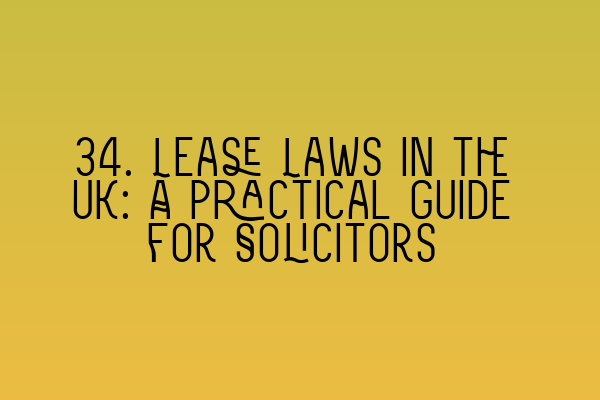Lease Laws in the UK: A Practical Guide for Solicitors
Welcome to SQE Property Law & Land Law! In this blog post, we will provide you with a practical guide on lease laws in the UK. As a solicitor, it is essential to have a strong understanding of lease laws to effectively assist your clients in any property-related matters. So, let’s dive in and explore the key aspects of lease laws in the UK.
1. What is a lease?
A lease is a legal agreement that grants a tenant (also known as a lessee) the right to use and occupy a property for a specified period, in exchange for regular payments (rent) to the landlord (also known as the lessor). Leases can vary in duration, ranging from short-term leases of a few months to long-term leases of several years or even decades.
If you are preparing for the SQE 1 exams and need practice questions, check out our SQE 1 Practice Exam Questions article.
2. Types of leases
There are different types of leases that you may come across as a solicitor. Some common types include:
- Assured Shorthold Tenancy (AST) – Most residential tenancies in the UK are ASTs, providing tenants with certain statutory rights and permitting landlords to regain possession after a fixed term.
- Commercial lease – Commercial leases are more complex and often involve longer durations. They govern the leasing of non-residential properties, such as offices, retail spaces, or industrial units.
- Ground lease – A ground lease grants the tenant the right to use the land for a specific purpose, usually for a long-term period. The tenant may need to build structures on the land.
- Assured Tenancy – Assured tenancies offer tenants increased security of tenure and certain rights under the Housing Act 1988.
If you are looking for SQE 1 preparation courses, click here: SQE 1 Preparation Courses.
3. Essential elements of a lease
A lease agreement should include certain essential elements to be legally enforceable. These elements include:
- Parties – Clearly identify the landlord and tenant, including their full names and addresses. Additionally, include any guarantors or agents involved.
- Description of the property – Provide a detailed description of the property being leased, including its address and any specific boundaries or features.
- Term – Specify the start date and duration of the lease. Include provisions for renewal or termination.
- Rent – Outline the amount of rent to be paid, the frequency of payments, and any applicable late payment or interest charges.
- Repairs and maintenance – Clearly define the responsibilities of both the landlord and tenant regarding repairs and maintenance of the property.
- Use of the property – Specify the permitted use of the property and any restrictions or limitations.
- Break clauses – If applicable, include any break clauses allowing an early termination of the lease.
- Insurance – Determine who is responsible for insuring the property and its contents.
4. Obligations and responsibilities
Both landlords and tenants have certain obligations and responsibilities under lease laws in the UK. It is crucial to identify and understand these obligations to ensure compliance and protect your client’s interests. Some key obligations include:
- Landlord’s obligations – Landlords are typically responsible for maintaining the structure and exterior of the property, ensuring the property is suitable for occupation, and addressing any repairs.
- Tenant’s obligations – Tenants are generally responsible for paying rent on time, keeping the property clean, and reporting any maintenance issues promptly.
If you’re looking for mock exams to practice your knowledge, take a look at our SQE 1 Practice Mocks FLK1 FLK2 article.
5. Termination of a lease
A lease can be terminated in various ways, including:
- Expiry of the term – When the lease reaches the end of its specified term, it terminates automatically, and the tenant must vacate the property.
- Notice to quit – Either the landlord or the tenant can give notice to quit in accordance with lease provisions or statutory requirements.
- Forfeiture – If a tenant breaches the lease agreement, the landlord may reclaim possession through forfeiture, subject to relevant legal procedures.
For more information on SRA SQE exam dates, check our SRA SQE Exam Dates page.
Conclusion
Lease laws play a critical role in the field of property law. As a solicitor, understanding the intricacies of lease agreements and the corresponding rights and responsibilities is essential for providing effective advice to your clients.
At SQE Property Law & Land Law, we offer comprehensive SQE 2 preparation courses to help you excel in your legal career. Visit our SQE 2 Preparation Courses page for more information.
We hope this practical guide on lease laws in the UK has been informative and helpful. If you have any further questions or require legal assistance, please do not hesitate to contact us.
